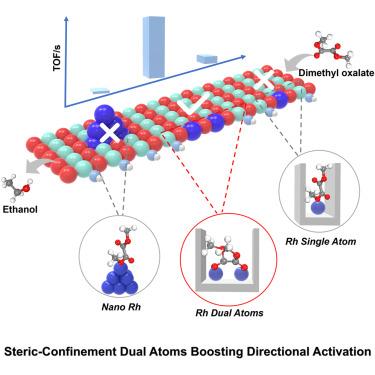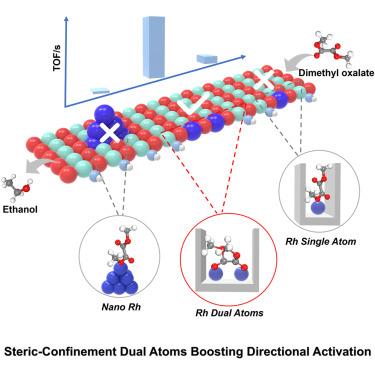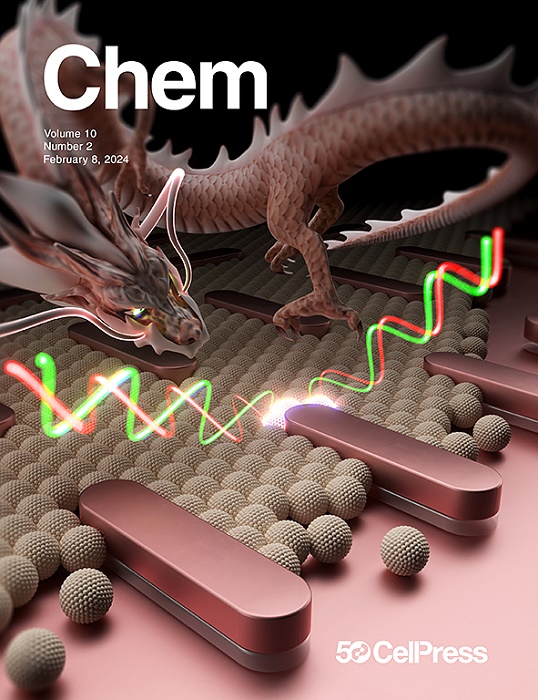Steric-confinement Rh2/MoS2 dual-atom catalyst directionally modulating adsorption configuration of ester group to boost ethanol synthesis
IF 19.1
1区 化学
Q1 CHEMISTRY, MULTIDISCIPLINARY
引用次数: 0
Abstract
Developing a new tactic for directionally regulating a specific functional group of feedstock molecules at the molecular level is highly desired to synthesize high-value products but remains challenging. We design and construct the two-dimensional molybdenum disulfide (2D MoS2) nanosheets edge-anchored dual Rh atoms (Rh2/MoS2 dual-atom catalyst [DAC]) to boost the ethanol yield in dimethyl oxalate (DMO) selective hydrogenation by precisely manipulating the DMO adsorption configuration. Comprehensive experimental and theoretical results reveal that the pocket-like active center of Rh2 atoms, with a precise metal-metal distance (3.5 Å), realizes the spatially matched bidentate DMO adsorption via two C=O groups (distance of 3.1 Å), which remarkably enhances the DMO activation and drives the production of ethanol via a unilateral activation mechanism. The turnover frequency (TOF) and H2/DMO molar ratio of Rh2/MoS2 DAC are around 19 times higher and 17 times lower, respectively, than those of the best reported catalysts under comparable conditions. Our results offer practical opportunities for updating the industrial syngas-DMO-ethanol route.


立体构型 Rh2/MoS2 双原子催化剂定向调节酯基吸附构型,促进乙醇合成
要合成高价值产品,开发一种在分子水平上定向调节原料分子特定官能团的新方法是非常必要的,但这仍然具有挑战性。我们设计并构建了二维二硫化钼(2D MoS2)纳米片边缘锚定双 Rh 原子(Rh2/MoS2 双原子催化剂 [DAC]),通过精确操纵 DMO 吸附构型,提高草酸二甲酯(DMO)选择性加氢反应中的乙醇产率。综合实验和理论结果表明,Rh2 原子的口袋状活性中心具有精确的金属-金属间距(3.5 Å),通过两个 C=O 基团(间距为 3.1 Å)实现了空间匹配的双齿 DMO 吸附,从而显著增强了 DMO 的活化,并通过单侧活化机制促进了乙醇的生成。在可比条件下,Rh2/MoS2 DAC 的翻转频率(TOF)和 H2/DMO 摩尔比分别比已报道的最佳催化剂高约 19 倍和低约 17 倍。我们的研究结果为更新工业合成气-DMO-乙醇路线提供了切实可行的机会。
本文章由计算机程序翻译,如有差异,请以英文原文为准。
求助全文
约1分钟内获得全文
求助全文
来源期刊

Chem
Environmental Science-Environmental Chemistry
CiteScore
32.40
自引率
1.30%
发文量
281
期刊介绍:
Chem, affiliated with Cell as its sister journal, serves as a platform for groundbreaking research and illustrates how fundamental inquiries in chemistry and its related fields can contribute to addressing future global challenges. It was established in 2016, and is currently edited by Robert Eagling.
 求助内容:
求助内容: 应助结果提醒方式:
应助结果提醒方式:


